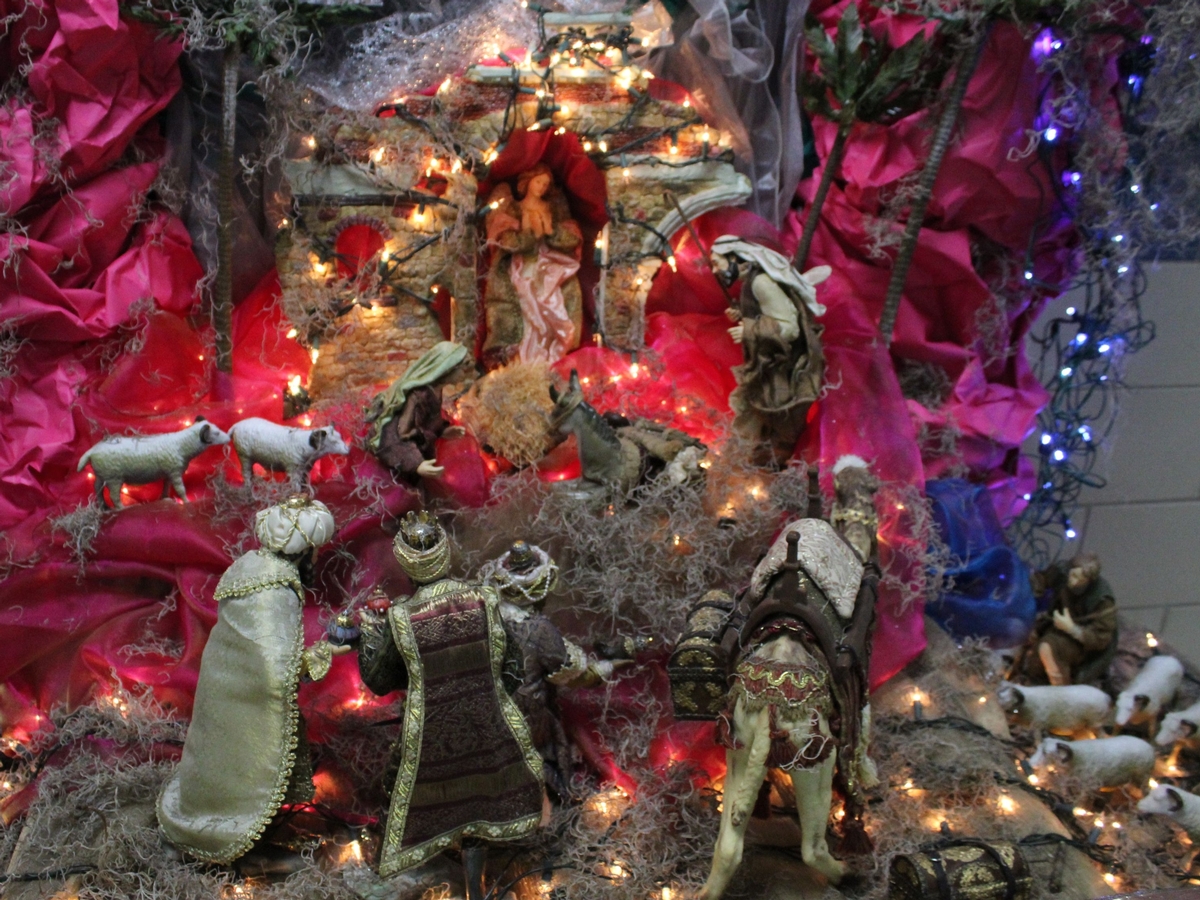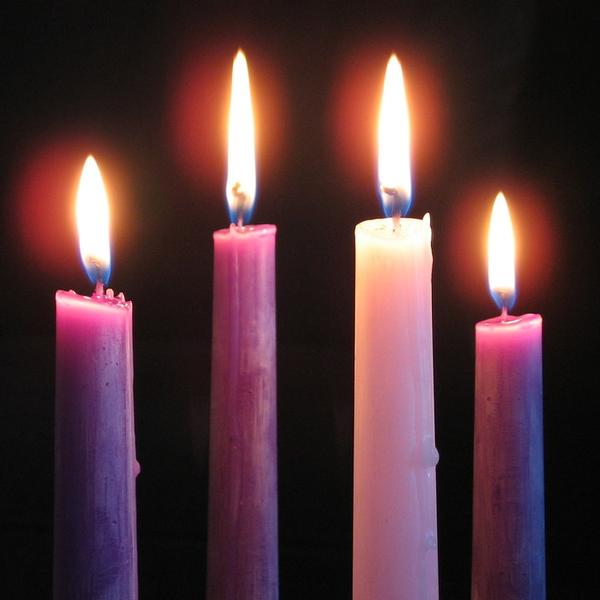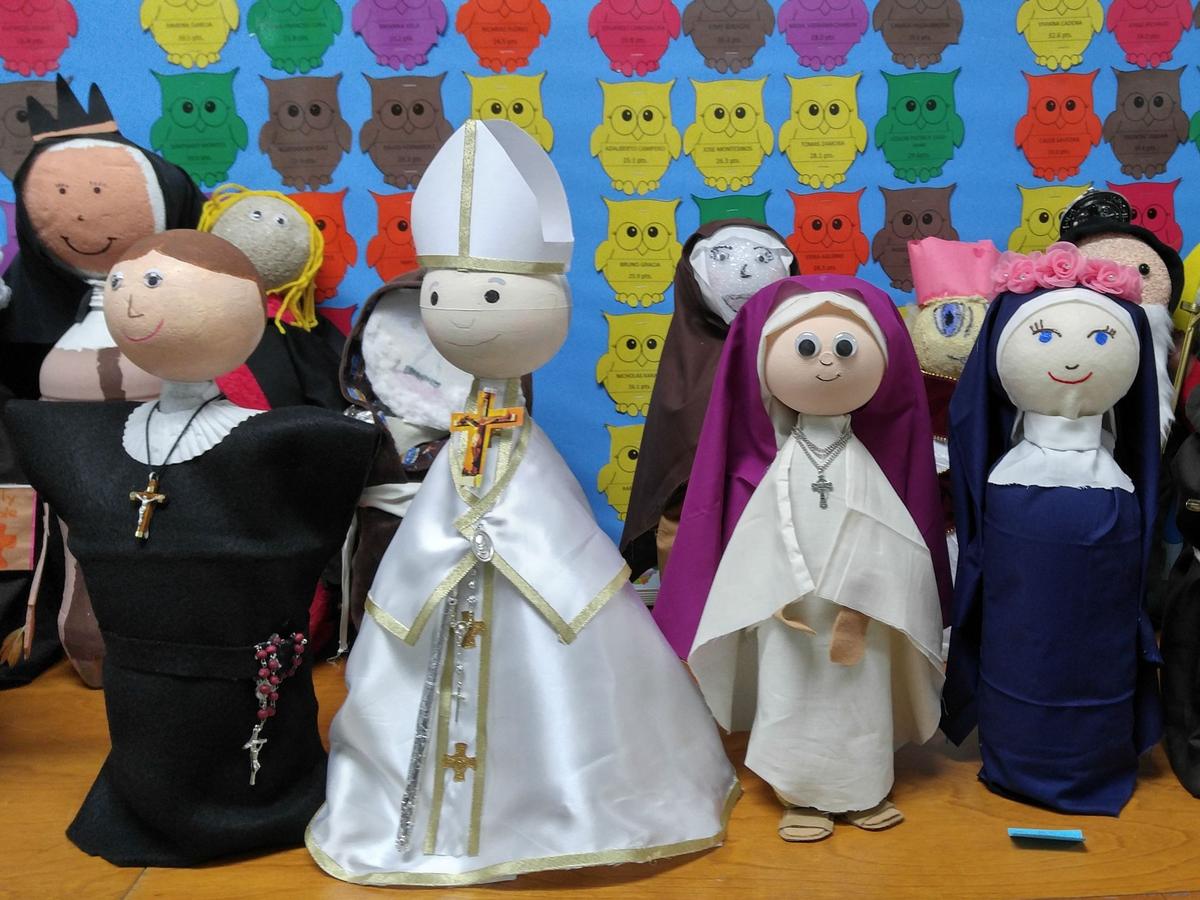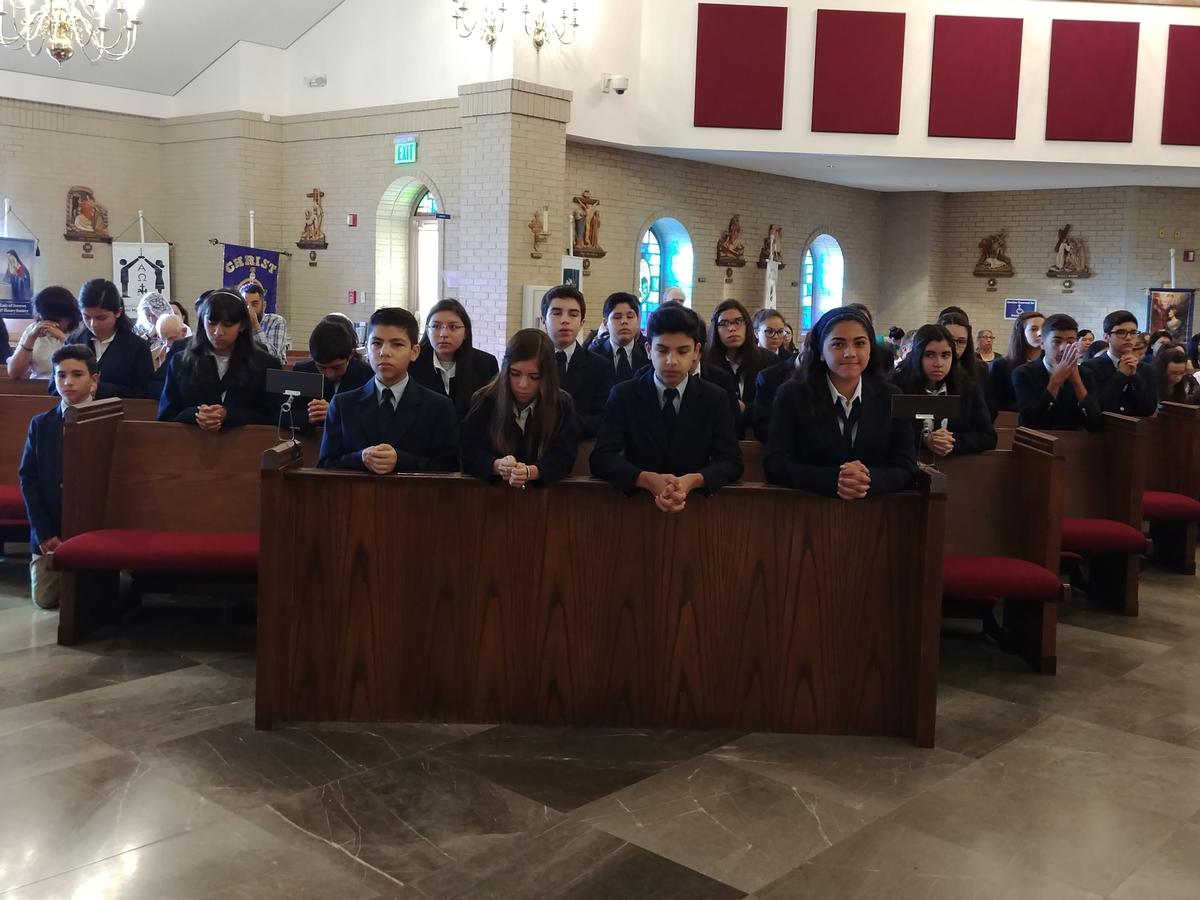The Advent Season

During the blessing given to the mother and father of a newly baptized child at the end of the Baptismal Liturgy, we hear these words: These parents will be the first teachers of their children in the faith, may they be also the best of teachers by what they say and do. The Second Vatican Council called each home and family “the domestic church.” With this in mind, the season of Advent provides an excellent opportunity for parents to nurture the faith of their whole family.
Buying (or making) an advent wreath and then setting up a prayer area in your home (somewhere near the living room or dining room, where it is clearly visible) to place it on is a good first step. Blessing the wreath, and then lighting the candle(s) before or after dinner each evening can become a way of keeping the focus of this Advent season on the coming of the Light of Christ.
Setting up a Jesse tree (especially a homemade one) can be another way of marking the days during Advent until we celebrate the birth of Jesus. Setting up Christmas lights inside or outside the home can be another way of remembering the light of Christ, especially as our days grow shorter and the nights grow longer.
Traditional Posadas or praying the rosary together are another way to fully prepare for the coming Christmas season both as a family and as an extended community. And of course, the best way to prepare is to attend Holy Mass together during the season of Advent every weekend and holy day—it helps to prepare the whole family to celebrate the birth of the Baby Jesus at the beginning of the Christmas season.
There are several documents you can download as part of this post (below my signature) that have prayers, activities, and ideas on helping families keep their focus not just on the fun of preparing for Christmas, but also on the preparation of our hearts, lives, and homes during the Advent season. In whatever ways your family prepares, remember that Jesus can stay at the center of our lives only with our attention and devotion to him—may we give God the best gift we can give him this Advent and Christmas season: our time.
Blessings & Peace,
Hugo De La Rosa III
Files for Download
Lent 2018

Prayer, fasting and almsgiving are the three ways that Jesus talks about our Lenten preparation in the Gospel reading for Ash Wednesday. These three avenues to holiness are traditionally prescribed for all Catholics, especially during Lent. Here are some ways we can incorporate these disciplines into our daily life, and especially into our Lenten sacrifices.
Prayer
When you pray, go to your inner room, close the door, and pray to your Father in secret.
Jesus said these words in the context of religious professionals who would pray for human acclaim. They prayed not so much out of a sincerity of heart, but for the sole purpose of having other people see them pray. They thrived on knowing that others thought they were holy and spiritual.
For our Lenten prayer discipline, we would do well to establish a regular habit of prayer. Morning and evening are natural times for prayer. We can rise 15 minutes earlier and spend some time in prayer, or we can wait until our house has settled down and make some time at night. In either case, a simple formula for prayer could flow like this:
- Take some time to still your body, quiet your breathing, silence your voice, and turn your thoughts towards God. (1 minute)
- Thank God for at least three (3) minutes. See how many different people, situations and things you can think of to give thanks for. (3 minutes)
- Acknowledge your faults before God - spend some time confessing your sins, failures, mistakes and regrets, and ask for God’s forgiveness .(3 minutes)
- Bring your petitions before God - pray for your family and friends, for our nation, for our Church, and for anyone who has asked you for their prayers. (3 minutes)
- Read Scripture - if you’re not sure what to read, open up Mark’s Gospel in the New Testament and read 1 chapter each time you pray. In less then 3 weeks you’ll have read through one full Gospel. (3 minutes)
- Listen for God’s voice - after talking and reading, spend the remaining two minutes listening for the still, small voice of the Holy Spirit. ( 2 minutes)
Fasting
But when you fast, anoint your head and wash your face, so that you may not appear to be fasting, except to your Father who is hidden.
Jesus spoke this in the context of people who would fast (not eat or drink) and then make a spectacle of it - they were, once again, looking for human praise. We can fast in secret by trying the following:
Food: We live in a country of such abundance that we sometimes forget that in other parts of our world (and in parts closer to home) some people go without food or live on very little food on a day to day basis. We can limit our intake of food and drink to remind ourselves of others, to stand in solidarity with them, and as a prayer for those who do not have enough to eat.
Electronics: We live in a world inundated with gadgets - cell phones, smart watches, mp3 players, laptops, computers, gigantic TV’s, etc. A challenging fast would be to go without non-essential electronics for a day, a week or all of Lent. It would help remind us that life is not always fast or convenient, and it would serve as a welcome antidote to the overloads of information and noise we sometimes try to process.
Almsgiving
But when you give alms, do not let your left hand know what your right is doing, so that your almsgiving may be secret.
Most Catholic parishes will have stewardship drives where we are asked to contribute our “time, talent and treasure.” Lent is a wonderful time for us to make sacrifices of all three of those precious commodities. We can spend more time on family and less on work or individual pursuits; more money on charities and less on frivolous spending; and more talents in the service of the poor and homeless in our midst. It is a great way to expand our self-centeredness into other-centeredness.
In whatever way you mark this Lent, I pray that it draws you closer to the suffering Servant. May we all become imitators of this Servant Messiah in our thoughts, words, and deeds.
Blessings & Peace,
Hugo De La Rosa III
2nd Week of Advent

During the blessing given to the mother and father of a newly baptized child at the end of the Baptismal Liturgy, we hear these words: These parents will be the first teachers of their children in the faith, may they be also the best of teachers by what they say and do. The Second Vatican Council called each home and family “the domestic church.” With this in mind, the season of Advent provides an excellent opportunity for parents to share their faith with the whole family.
Buying (or making) an advent wreath and then setting up a prayer area in your home (somewhere near the living room or dining room, where it is clearly visible) to place it on is a good first step. Blessing the wreath, and then lighting the candle(s) before or after dinner each evening can become a way of keeping the focus of this Advent season on the coming of the Light of Christ.
Setting up a Jesse tree (especially a homemade one) can be another way of marking the days during Advent until we celebrate the birth of Jesus. Setting up Christmas lights inside or outside the home can be another way of remembering the light of Christ, especially as our days grow shorter and the nights grow longer.
Traditional Posadas or praying the rosary together are another way to fully prepare for the coming Christmas season. And of course, the best way to prepare is to attend Mass together during the season of Advent—it will help to prepare the whole family to celebrate the birth of the Baby Jesus at the beginning of the Christmas season.
In whatever ways your family prepares, remember that Jesus can stay at the center of our lives only with our attention and devotion to him—may we give God the best gift we can ever give him this Advent and Christmas season—our time.
Blessings & Peace,
Hugo De La Rosa III
The Communion of Saints

This week we celebrate two interrelated feasts: The Solemnity of All Saints on November 1st, and The Commemoration of All the Faithful Departed (All Souls / Dia de los Muertos) on November 2nd. Both of these feasts center on the reality that we are still connected to our ancestors in faith and in family. They remind us that, even though we cannot see them, those who have passed away are still very much a part of our life.
The Solemnity of All Saints focuses on those people who have lived such exemplary lives of holiness that the Church feels justified in saying they are already enjoying the beatific vision - that they are living in the full presence of God. All Souls expands the focus, centering on all of our beloved dead. Both feasts echo the teaching in our creed: “We believe in the communion of saints.”
Since we are all one in Christ Jesus, we believe that our deceased friends and relatives can still influence our lives. They can bring our prayers and petitions to the very throne of God, interceding on our behalf; just as we can ask St. Michael, or St. Teresa, or St. Joseph to pray for us, so we can ask our deceased grandmother, uncle, or parent to pray for us as well.
We can also pray for our deceased relatives and friends, asking mercy on their behalf before God, our merciful judge. We can pray for a speedy movement through purgatory, and we can pray for the rest of their eternal souls.
Finally, we can look to the lives of the saints and draw encouragement from them - priests, popes, nuns, couples, and children. We can do our best to imitate them as they imitated Christ. With over 10,000 saints officially recognized by our Church, there will be saints that resonate with us because of our age, our profession, or our current needs. There will also be saints that challenge us to pursue holiness, or to think about our faith in ways that help us appreciate the universal call to holiness in every age, every culture, and every language.
In these two intertwined feasts, we remember that out of sight does not equate to out of mind. And we pray that one day, we also will be able to see God face to face, and take our place among a long line of people who prayed that we would one day enter into heaven.
Blessings & Peace,
Hugo De La Rosa III
Daily Prayers

Faculty, staff and students at Our Lady of Sorrows Catholic School pause throughout the day to pray together as a community.
Our first community prayer takes place in the gym (for 1st - 8th grade) or in the classroom (for Montessori). Each classroom (teacher/students) is assigned a week to lead the school in morning prayer in the gym, as well as serve the wider community by taking service and ministry roles at that week's celebration of Holy Mass. Kinder 5 students have the opportunity to serve at Mass at the end of the year as well.
The next time that 1st - 8th grade students pray together is in their classroom, sometimes utilizing their classroom altars. Self-contained classrooms will generally pray at the start and end of the day, while Jr. High classes will pray at the beginning and end of each different class they attend. Montessori students are taught to pray at their classroom altar with a short prayerful ritual at any time they would like, and the rest of the class is taught to be respectful of their classmates when they are in prayer.
Our next prayer pause is the Prayer Before Meals. Each class prays this together before they head out to recess and lunch.
At Noon the whole school pauses for a few minutes to pray the Angelus. It's a prerecorded audio file that is played over the schools intercom system, and it gives us all a chance to invoke Mary's protection and prayers for us as the patroness of the school.
Finally, at the end of the day, the whole school pauses once more to pray part of the Divine Mercy prayer together. It helps bring our school day to a close, and it helps to remind all of us that God is watching over us, and that his merciful love and forgiveness are always with us.
In your own homes, having a set time for prayer will help children understand the importance of prayer, while helping to bond family members together. The prayers we use at school are at the bottom of this article. You may want to use these at home as your children are very familiar with them. Every religion book we use also has a selection of Catholic prayers, either at the beginning or end of the book.
May the peaceful presence of the Holy Spirit lead you ever deeper into prayer this school year.
Blessings & Peace,
Hugo De La Rosa III
Morning Assembly – Ending Prayer
Leader: We adore you, O Christ, and we praise you
Response: Because by your holy cross you have redeemed the world.
Noontime Prayer – The Angelus
Leader: The Angel of the Lord declared to Mary:
Response: And she conceived of the Holy Spirit.
Hail Mary, full of grace . . .
Leader: Behold the handmaid of the Lord:
Response: Be it done unto me according to your word.
Hail Mary, full of grace . . .
Leader: And the Word was made Flesh:
Response: And dwelt among us.
Hail Mary, full of grace . . .
Leader: Pray for us, O Holy Mother of God,
Response: That we may be made worthy of the promises of Christ.
Let us pray:
Pour forth, we ask you, O Lord, your grace into our hearts; that as we have known the incarnation of Christ, your Son, by the message of an angel, so by His passion and cross we may be brought to the glory of His Resurrection. Through the same Christ, our Lord. Amen.
End of the Day Prayer – 3 O’Clock Prayer to The Divine Mercy
You expired, Jesus, but the source of life gushed forth for souls and an ocean of mercy opened up for the whole world. O Fountain of Life, unfathomable Divine Mercy, envelop the whole world and empty Yourself out upon us. O Blood and Water, which gushed forth from the Heart of Jesus as a fountain of mercy for us, I trust in You.
Holy God, Holy Mighty One, Holy Immortal One, have mercy on us and the whole world. (3 times)
Jesus, King of Mercy, I trust in You!
A Sabbath Spirituality of Sleep

“Sleep is the prayer of a creature secure in God’s love.” - Unknown
Remember the Sabbath day, and keep it holy. - Exodus 20:8
After taking an informal poll of students on campus, it seems some of them are not sleeping as much as they should, either because of extracurricular activities, homework, digital time, or other activities.
However, children need sleep to help them develop appropriately. Studies show that children who don't get enough sleep find it easier to fall asleep or zone out during class, have a harder time concentrating, have lower overall grades than their peers, and have a harder time remembering schoolwork or retaining memories. Especially for children, lack of sleep may also lead to an improper diagnosis of ADHD. Many children who don't get enough sleep become hyperactive, making it hard to accurately diagnose ADD or ADHD instead of just lack of sleep.
Physically, sleep releases a growth hormone that helps tissues grow properly, forms new red blood cells, helps deliver oxygen to the brain, and helps in promoting bone growth. Sleep also rejuvenates the body after physical exertion, and it restores our mind after mental exertion (especially needed for children with demanding classwork and homework!).
Spiritually, sleep is part of living out the Third Commandment (quoted above). When God asks us to keep holy the Sabbath, he is not just talking about regular Mass attendance (as important as that is). We are called to give equal time to our God, our family, our responsibilities, and our full self: body, mind, soul & spirit.
When we follow through on the full implications of the Third Commandment, we come to realize that God calls us to take care of ourselves. And part of that care is sleep.
The deeper issue, however, comes to our priorities—where we put the emphasis of our lives.
Most Americans spend much of their waking lives working. In and of itself, that's good. We work to provide for our families, to ensure our survival, and to have the means to help others. However, according to the US Census Bureau, Americans work an average of twenty more days per year than we did 25 years ago. And according to numerous studies, almost half of all employed Americans don't take any vacation time each year. We've become a nation of workaholics.
In the midst of this, God calls us to peace and rest. God challenges us to let go of our fantasies: that we're in charge, that we're indispensable, that our work is more important that our families or our health, that rest equals laziness, and that money is more valuable than time.
Only in letting go of these power trips can we let the grace of the Spirit into our lives. And part of that letting go, as simple as it sounds, is in getting enough sleep.
When we sleep, we're no longer in control—we can't make decisions, send email, or give orders. The rest of the world goes on without us. We learn to let go. As the first quote states, we learn to trust in God, to have faith that the God who works behind the scenes during our waking life is also working behind the scenes as we sleep.
My prayer for our whole OLS community is that, contrary to our American mind-set, we sleep more, relax more, unwind, calm down and slow down, so that when we do, the freedom of Christ will rule our hearts, and we will no longer be held in bondage by our watches, cell phones, calendars, or planners.
How Much Sleep Should My Child Get?
The following are rough guidelines on the amount of sleep children need (the listed amounts can vary by up to an hour more or an hour less needed sleep for different children). The amount of sleep needed may also vary depending on physical or mental activity, time of the year, emotional strain, and other factors.
Age Range / Sleep Needed
0-1 / 13-17 hours
1-3 / approx. 13 hours
3-8 / 10-12 hours (day-time naps "count")
8-12 / approx. 10 hours
12-15 / approx. 9 hours
15-19 / 8-9 hours
19+ / 6-8 hours
Help for Getting Kids (and Adults) to Sleep
The following tips may help children and adults who have trouble turning in for the night:
- Establish a bed-time ritual. Include time to wind down, and give your children “bedtime alerts” a 1/2 hour and 10 minutes before it is time to go to bed.
- Choose and stick to a bed time—it’s easier to fall asleep if there is consistency in the routine.
- Create a comfortable bedroom—dark, cool & quiet are three great keywords to help induce sleep.
- Engage in exercise or some form of physical activity in the late afternoon/early evening to help the body wind down by bed time. Don’t engage in physically strenuous activity right before bed time.
- Limit drinks before bedtime. Drinks with caffeine (and alcohol, for those over 21) should be limited (or not taken at all) after lunch.
- Avoid large meals close to bed time. However, try not to go to sleep without eating anything at all—some yogurt, fruit, or other nutritious snack before going to bed will help ward off the midnight munchies.
- Keep the whole house quiet at bedtime—it’s hard for kids to fall asleep with loud music playing or a loud TV blaring.
- Limit screen time (phone, tablet, laptop, computer, TV) before bed-time—bright lights signal the brain to wake up, not fall asleep.
- Limit napping during the day.
- Try and keep the same sleep and waking schedule during the weekend, especially for younger children—having to adjust and re-adjust sleep schedules is hard. If you must adjust, do not adjust by more than 1 or 2 hours.
- Set consistent homework/study time every evening, so that children (especially older ones) don’t have to stay up late and cram for tests the night before.
- Assess the amount of time spent on extracurricular activities—if it’s taking time away from study and sleep, consider cutting back, especially if children are involved in more than one after-school activity. Stress and over-stimulation are not conducive to restful sleep.
Keep in mind that bed time is the time that sleep actually occurs. If it takes your child 20 minutes to fall asleep, adjust his or her bed time routine so that it starts a little earlier and gives the proper amount of sleep.
Blessings & Peace,
Hugo De La Rosa III
